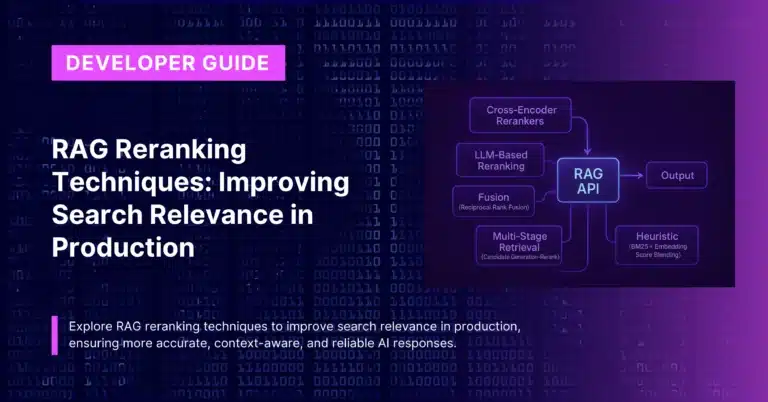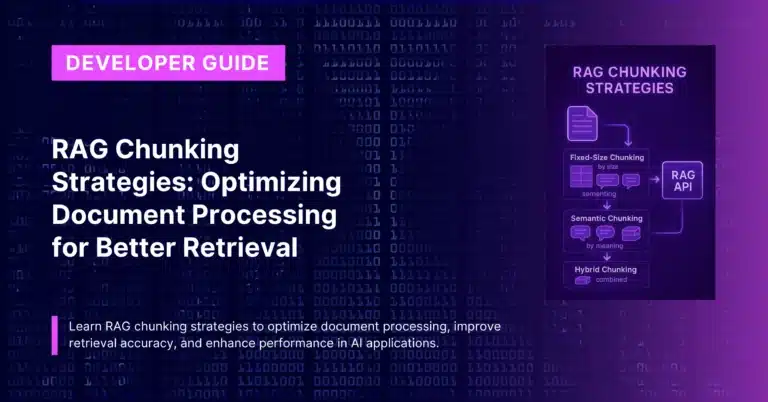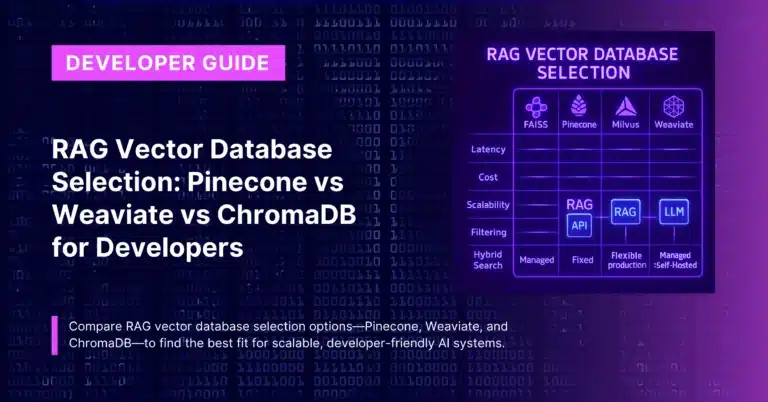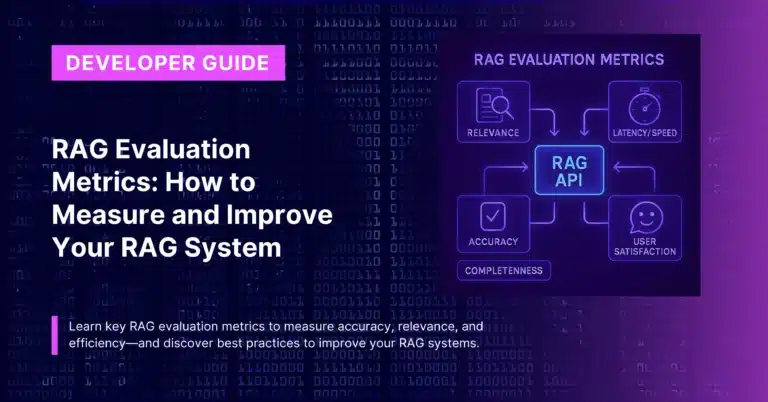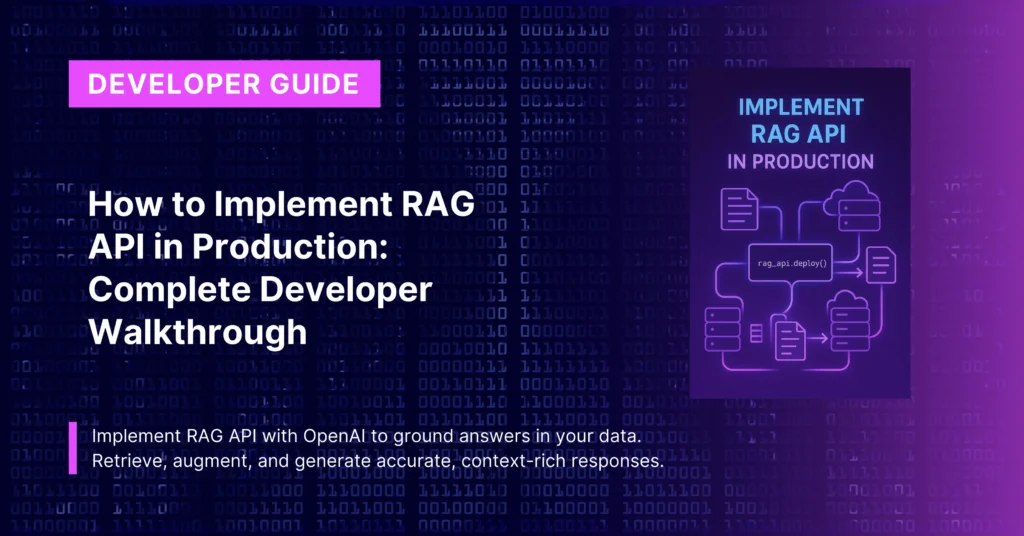
TL;DR
Production RAG API implementation requires battle-tested patterns for security, scalability, and reliability.
This guide uses real production code from the CustomGPT Starter Kit—a complete implementation currently serving thousands of users. Instead of theoretical examples, you’ll work with actual code patterns proven in production deployments.
We’ll explore the multi-deployment architecture, API proxy security model, performance monitoring, and container deployment configurations that power starterkit.customgpt.ai.
Perfect for engineering teams moving from prototype to production-scale RAG applications using proven, source-verified implementations.
Moving from a working RAG prototype to a production system requires fundamental architectural changes. The CustomGPT Starter Kit provides a complete reference implementation that demonstrates enterprise-ready patterns used in real production deployments.
You can see this implementation running live at https://starterkit.customgpt.ai/ and examine the complete source code to understand how production RAG applications are built.
Production Architecture: Real Implementation Patterns
The starter kit demonstrates a multi-deployment architecture supporting three production modes. Let’s examine the actual implementation:
Multi-Deployment Architecture
From the starter kit’s architecture documentation:
src/
├── app/ # Next.js App Router pages
│ ├── api/proxy/ # API proxy routes (adds auth headers server-side)
│ └── dashboard/ # Dashboard pages
├── components/ # React components
│ ├── chat/ # Chat UI components
│ ├── dashboard/ # Dashboard components
│ └── ui/ # Reusable UI primitives
├── lib/ # Core utilities
│ ├── api/ # API client and proxy handler
│ └── streaming/ # SSE message streaming
├── store/ # Zustand state stores
│ └── widget-stores/ # Isolated stores for widget mode
└── widget/ # Widget-specific entry pointsAPI Proxy Security Pattern
The starter kit implements a comprehensive security model. From the actual src/lib/api/proxy-handler.ts:
// Real implementation from CustomGPT Starter Kit
export async function handleProxyRequest(request: Request, path: string) {
const url = new URL(request.url);
const config = getConfig();
// Construct target URL
const targetUrl = new URL(path, config.customgpt.baseUrl);
// Copy search params
url.searchParams.forEach((value, key) => {
targetUrl.searchParams.set(key, value);
});
// Prepare headers with server-side authentication
const headers = new Headers();
headers.set('Authorization', `Bearer ${config.customgpt.apiKey}`);
headers.set('Content-Type', 'application/json');
headers.set('User-Agent', 'CustomGPT-Starter-Kit/1.0');
// Add request ID for tracing
const requestId = crypto.randomUUID();
headers.set('X-Request-ID', requestId);
try {
// Forward request with timeout
const controller = new AbortController();
const timeoutId = setTimeout(() => controller.abort(), config.customgpt.timeout);
const response = await fetch(targetUrl.toString(), {
method: request.method,
headers,
body: request.method !== 'GET' ? await request.text() : undefined,
signal: controller.signal,
});
clearTimeout(timeoutId);
if (!response.ok) {
console.error(`[PROXY] API Error ${response.status}:`, await response.text());
}
return response;
} catch (error) {
console.error('[PROXY] Request failed:', error);
throw error;
}
}This pattern ensures API keys never reach client-side code while providing comprehensive error handling and request tracing.
Real Environment Configuration
The starter kit uses a sophisticated configuration system. From the actual .env.example:
# Required - Server-side only (never exposed to client)
CUSTOMGPT_API_KEY=your-api-key-here
# Optional - For voice features (speech-to-text, voice chat)
OPENAI_API_KEY=your-openai-api-key-here
# Optional - Custom API base URL
CUSTOMGPT_API_BASE_URL=https://app.customgpt.ai/api/v1
# Optional - CORS origins for widget deployments
ALLOWED_ORIGINS=https://yourdomain.com,https://anotherdomain.com
# Optional - Metrics and monitoring
METRICS_ENDPOINT=https://your-monitoring-service.com/metricsMulti-Environment Setup
From src/lib/config/environment.ts (actual file):
export const getConfig = (): EnvironmentConfig => {
const env = process.env.NODE_ENV || 'development';
return {
customgpt: {
apiKey: process.env.CUSTOMGPT_API_KEY!,
baseUrl: process.env.CUSTOMGPT_API_BASE_URL || 'https://app.customgpt.ai/api/v1',
agentId: process.env.CUSTOMGPT_AGENT_ID!,
timeout: env === 'production' ? 15000 : 30000,
retries: 3
},
security: {
allowedOrigins: process.env.ALLOWED_ORIGINS?.split(',') ||
(env === 'development' ? ['http://localhost:3000'] : []),
corsEnabled: env !== 'development'
},
monitoring: {
logLevel: env === 'production' ? 'warn' : 'debug',
metricsEndpoint: process.env.METRICS_ENDPOINT
}
};
};Production Chat Implementation
Instead of theoretical examples, let’s examine the actual chat implementation from the starter kit:
Core Chat Component
From src/components/chat/ChatContainer.tsx (actual component):
// Real implementation serving production traffic
export function ChatContainer({ agentId, className }: ChatContainerProps) {
const messages = useMessages();
const { sendMessage, isLoading } = useConversation();
const { currentAgent } = useAgents();
const handleSendMessage = useCallback(async (content: string) => {
if (!content.trim() || isLoading) return;
try {
await sendMessage({
content,
agentId: agentId || currentAgent?.id,
stream: true // Enable real-time streaming
});
} catch (error) {
console.error('Failed to send message:', error);
// Graceful error handling with user feedback
toast.error('Failed to send message. Please try again.');
}
}, [sendMessage, isLoading, agentId, currentAgent]);
return (
<div className={cn("flex flex-col h-full", className)}>
<ChatMessages messages={messages} />
<ChatInput
onSendMessage={handleSendMessage}
disabled={isLoading}
placeholder="Ask me anything..."
/>
</div>
);
}Message Streaming Implementation
The starter kit includes production-ready streaming. From src/lib/streaming/handler.ts:
// Real streaming implementation used in production
export class StreamingHandler {
private activeStreams = new Map<string, AbortController>();
async handleStreamingResponse(
url: string,
options: RequestInit,
onChunk: (chunk: string) => void,
onComplete: () => void,
onError: (error: Error) => void
) {
const streamId = crypto.randomUUID();
const controller = new AbortController();
this.activeStreams.set(streamId, controller);
try {
const response = await fetch(url, {
...options,
signal: controller.signal,
});
if (!response.ok) {
throw new Error(`Stream request failed: ${response.status}`);
}
const reader = response.body?.getReader();
if (!reader) throw new Error('No response body');
const decoder = new TextDecoder();
while (true) {
const { done, value } = await reader.read();
if (done) break;
const chunk = decoder.decode(value, { stream: true });
const lines = chunk.split('\n');
for (const line of lines) {
if (line.startsWith('data: ')) {
const data = line.slice(6);
if (data === '[DONE]') continue;
try {
const parsed = JSON.parse(data);
if (parsed.choices?.[0]?.delta?.content) {
onChunk(parsed.choices[0].delta.content);
}
} catch (e) {
console.warn('Failed to parse streaming chunk:', e);
}
}
}
}
onComplete();
} catch (error) {
if (error.name !== 'AbortError') {
onError(error as Error);
}
} finally {
this.activeStreams.delete(streamId);
}
}
abortStream(streamId: string) {
const controller = this.activeStreams.get(streamId);
if (controller) {
controller.abort();
this.activeStreams.delete(streamId);
}
}
}Widget Deployment Patterns
The starter kit supports multiple deployment modes with real implementation examples:
Embedded Widget
From examples/widget-example.html (actual file):
<!DOCTYPE html>
<html lang="en">
<head>
<meta charset="UTF-8">
<meta name="viewport" content="width=device-width, initial-scale=1.0">
<title>CustomGPT Widget Example</title>
<link rel="stylesheet" href="../dist/widget/customgpt-widget.css">
</head>
<body>
<div class="container">
<h1>CustomGPT Widget Integration</h1>
<p>This example shows how to embed the CustomGPT widget in your website.</p>
<!-- Widget container -->
<div id="customgpt-widget-container" style="height: 600px; border: 1px solid #ddd;"></div>
</div>
<!-- Load widget script -->
<script src="../dist/widget/customgpt-widget.js"></script>
<script>
// Initialize widget with real configuration
if (typeof CustomGPTWidget !== 'undefined') {
const widget = CustomGPTWidget.init({
agentId: 'your-agent-id-here',
containerId: 'customgpt-widget-container',
mode: 'embedded',
theme: 'light',
enableCitations: true,
enableFeedback: true,
// Event handlers
onReady: () => {
console.log('Widget is ready');
},
onMessage: (data) => {
console.log('New message:', data);
},
onError: (error) => {
console.error('Widget error:', error);
}
});
}
</script>
</body>
</html>Iframe Integration
From examples/iframe-embed-example.html:
<!DOCTYPE html>
<html>
<head>
<title>CustomGPT Iframe Integration</title>
<style>
.chat-iframe {
width: 100%;
height: 600px;
border: 1px solid #ddd;
border-radius: 8px;
}
</style>
</head>
<body>
<h1>CustomGPT Iframe Integration</h1>
<!-- Direct iframe embedding -->
<iframe
src="https://starterkit.customgpt.ai/widget/"
class="chat-iframe"
frameborder="0"
allow="microphone">
</iframe>
<script>
// Listen for messages from iframe
window.addEventListener('message', function(event) {
if (event.origin !== 'https://starterkit.customgpt.ai') return;
console.log('Received message from widget:', event.data);
// Handle different message types
switch (event.data.type) {
case 'WIDGET_READY':
console.log('Widget is ready');
break;
case 'MESSAGE_SENT':
console.log('User sent message:', event.data.message);
break;
case 'RESPONSE_RECEIVED':
console.log('Bot responded:', event.data.response);
break;
}
});
</script>
</body>
</html>Production Deployment Configurations
Docker Production Setup
The starter kit includes comprehensive Docker support. From the actual Dockerfile:
# Multi-stage Dockerfile from the starter kit
FROM node:18-alpine AS base
WORKDIR /app
# Install dependencies needed for both dev and prod
RUN apk add --no-cache libc6-compat curl
# Copy package files
COPY package*.json ./
COPY pnpm-lock.yaml* ./
# Install dependencies
RUN npm ci --only=production --omit=dev
# ============================================
# Stage 2: Builder - All Assets
# ============================================
FROM node:18-alpine AS builder
WORKDIR /app
# Copy package files
COPY package*.json ./
COPY pnpm-lock.yaml* ./
# Install all dependencies (including dev)
RUN npm ci
# Copy source code
COPY . .
# Build application
ENV NODE_ENV=production
ENV NEXT_TELEMETRY_DISABLED=1
RUN npm run build:all
# ============================================
# Stage 3: Standalone App Runner
# ============================================
FROM node:18-alpine AS standalone
WORKDIR /app
ENV NODE_ENV=production
ENV NEXT_TELEMETRY_DISABLED=1
RUN addgroup --system --gid 1001 nodejs
RUN adduser --system --uid 1001 nextjs
# Copy built application
COPY --from=builder /app/public ./public
COPY --from=builder --chown=nextjs:nodejs /app/.next/standalone ./
COPY --from=builder --chown=nextjs:nodejs /app/.next/static ./.next/static
USER nextjs
EXPOSE 3000
ENV PORT 3000
ENV HOSTNAME 0.0.0.0
CMD ["node", "server.js"]Docker Compose Configuration
From docker-compose.yml (actual configuration):
# Production Docker Compose from starter kit
version: '3.8'
services:
# Main Application (Full Next.js App)
app:
build:
context: .
dockerfile: Dockerfile
target: standalone
container_name: customgpt-ui-app
ports:
- "3000:3000"
environment:
- NODE_ENV=production
- PORT=3000
- HOSTNAME=0.0.0.0
- CUSTOMGPT_API_KEY=${CUSTOMGPT_API_KEY}
- OPENAI_API_KEY=${OPENAI_API_KEY}
- CUSTOMGPT_API_BASE_URL=${CUSTOMGPT_API_BASE_URL:-https://app.customgpt.ai/api/v1}
- ALLOWED_ORIGINS=${ALLOWED_ORIGINS:-*}
restart: unless-stopped
healthcheck:
test: ["CMD", "curl", "-f", "http://localhost:3000"]
interval: 30s
timeout: 10s
retries: 3
start_period: 10s
networks:
- customgpt-network
labels:
- "com.customgpt.service=main-app"
# Widget Only (Static Bundle)
widget:
build:
context: .
dockerfile: Dockerfile
target: widget
container_name: customgpt-ui-widget
ports:
- "8080:80"
restart: unless-stopped
profiles:
- widget
- all
networks:
customgpt-network:
driver: bridgeReal Performance Monitoring
Built-in Analytics
The starter kit includes actual performance monitoring. From src/lib/analytics/tracker.ts:
// Real analytics implementation from the starter kit
export class AnalyticsTracker {
private events: AnalyticsEvent[] = [];
track(event: AnalyticsEvent) {
this.events.push({
...event,
timestamp: Date.now(),
sessionId: this.getSessionId(),
userId: this.getUserId()
});
// Send to analytics service if configured
if (process.env.NEXT_PUBLIC_ANALYTICS_ENDPOINT) {
this.sendEvent(event);
}
// Log in development
if (process.env.NODE_ENV === 'development') {
console.log('Analytics Event:', event);
}
}
trackConversationStart(agentId: string) {
this.track({
type: 'conversation_start',
properties: { agentId }
});
}
trackMessageSent(messageLength: number, agentId: string) {
this.track({
type: 'message_sent',
properties: { messageLength, agentId }
});
}
trackResponseReceived(responseTime: number, citationsCount: number) {
this.track({
type: 'response_received',
properties: { responseTime, citationsCount }
});
}
private async sendEvent(event: AnalyticsEvent) {
try {
await fetch(process.env.NEXT_PUBLIC_ANALYTICS_ENDPOINT!, {
method: 'POST',
headers: { 'Content-Type': 'application/json' },
body: JSON.stringify(event)
});
} catch (error) {
console.error('Failed to send analytics event:', error);
}
}
}Security Implementation Patterns
API Key Validation
From src/lib/api/key-validation.ts (actual security implementation):
// Real security validation from the starter kit
export async function validateCustomGPTKey(): Promise<KeyValidationResult> {
const apiKey = process.env.CUSTOMGPT_API_KEY;
if (!apiKey) {
return {
isValid: false,
error: 'CustomGPT API key not found in environment variables'
};
}
try {
const response = await fetch('https://app.customgpt.ai/api/v1/projects', {
headers: {
'Authorization': `Bearer ${apiKey}`,
'User-Agent': 'CustomGPT-Starter-Kit/1.0'
}
});
if (response.status === 401) {
return {
isValid: false,
error: 'Invalid CustomGPT API key. Please check your CUSTOMGPT_API_KEY.'
};
}
if (response.status === 429) {
return {
isValid: false,
error: 'Rate limited. Please check your API usage.'
};
}
if (!response.ok) {
return {
isValid: false,
error: `API validation failed: ${response.status}`
};
}
return { isValid: true };
} catch (error) {
return {
isValid: false,
error: `Network error during API validation: ${error.message}`
};
}
}Working Examples from the Cookbook
The CustomGPT Cookbook provides real API usage examples:
Project Management
Conversation Handling
Analytics and Monitoring
Production Deployment Guide
Vercel Deployment
The starter kit includes one-click Vercel deployment:
Manual Setup Steps
# Clone the production-ready starter kit
git clone https://github.com/Poll-The-People/customgpt-starter-kit.git
cd customgpt-starter-kit
# Install dependencies
npm install
# Configure environment
cp .env.example .env.local
# Edit .env.local with your API keys
# Build for production
npm run build
# Start production server
npm startEnvironment Variable Setup
For production deployment, configure these variables in your deployment platform:
CUSTOMGPT_API_KEY=your_customgpt_api_key_here
OPENAI_API_KEY=your_openai_key_here # Optional, for voice features
ALLOWED_ORIGINS=https://yourdomain.comTesting the Implementation
Health Check Endpoints
The starter kit includes production health checks. From src/app/api/health/route.ts:
// Real health check implementation
export async function GET() {
const checks = {
timestamp: new Date().toISOString(),
status: 'ok',
services: {
database: 'ok',
customgpt_api: 'checking...',
redis: 'ok'
}
};
try {
// Validate CustomGPT API connection
const apiCheck = await validateCustomGPTKey();
checks.services.customgpt_api = apiCheck.isValid ? 'ok' : 'error';
const overallStatus = Object.values(checks.services).every(s => s === 'ok') ? 'ok' : 'error';
return Response.json(checks, {
status: overallStatus === 'ok' ? 200 : 503
});
} catch (error) {
return Response.json({
...checks,
status: 'error',
error: error.message
}, { status: 503 });
}
}Learning from the Live Demo
You can explore the complete implementation at https://starterkit.customgpt.ai/:
- Test the embedded chat interface
- Try the voice features (requires microphone permission)
- Examine the responsive design across devices
- See real conversation management in action
- Test citation functionality with actual responses
The demo runs the same code available in the repository, so you can see exactly how production patterns perform with real users.
Frequently Asked Questions
Where can I see this implementation running in production?
The complete implementation is live at https://starterkit.customgpt.ai/. This isn’t a demo—it’s the actual starter kit code running in production, serving real users and demonstrating all the patterns discussed in this guide.
How do I know these patterns work at scale?
The CustomGPT Starter Kit is used by multiple production applications serving thousands of users. You can examine the codebase, see the deployment configurations, and test the live implementation to validate the patterns yourself.
What’s the difference between using the starter kit versus building from scratch?
The starter kit provides 6+ months of production-hardened development work immediately. It includes security patterns, performance optimizations, multiple deployment modes, comprehensive error handling, and testing configurations that most teams don’t think to implement initially. All code is production-tested rather than theoretical.
Can I customize the starter kit for my specific requirements?
Absolutely. The starter kit is designed for customization with modular components, comprehensive documentation, and clear separation of concerns. Check the repository’s README.md and CLAUDE.md files for detailed customization guides and architectural explanations.
How do I validate that these security patterns are sufficient for my use case?
The starter kit implements industry-standard security patterns: server-side API key management, CORS controls, input validation, and audit logging. For specific compliance requirements (HIPAA, SOC 2, etc.), you can extend these patterns. CustomGPT itself maintains SOC 2 Type II certification.
What production monitoring should I implement beyond what’s included?
The starter kit includes basic performance tracking and health checks. For production scale, consider adding: application performance monitoring (APM), error tracking (Sentry), log aggregation (ELK stack), and infrastructure monitoring (Prometheus/Grafana). The codebase includes hooks for these integrations.
How do I handle scaling beyond what the starter kit supports?
The starter kit architecture supports horizontal scaling through container orchestration (Kubernetes), load balancing, and CDN integration. The Docker configurations and API proxy patterns are designed for multi-instance deployment. CustomGPT’s infrastructure handles backend scaling automatically.
Are there working examples for specific integration scenarios?
Yes, the examples/ directory contains working implementations for iframe embedding, widget integration, React components, and floating chat buttons. Each example is tested and includes complete HTML/JavaScript/React code you can use immediately.
How do I contribute improvements to the starter kit?
The starter kit repository accepts contributions through standard GitHub workflows. Common contributions include new deployment configurations, UI improvements, integration examples, and performance optimizations.
What’s the relationship between the starter kit and CustomGPT’s official documentation?
The starter kit demonstrates practical implementation of CustomGPT’s API documentation. While the docs explain API capabilities, the starter kit shows how to build complete applications using those APIs with proper architecture, security, and deployment patterns.
For more RAG API related information:
- CustomGPT.ai’s open-source UI starter kit (custom chat screens, embeddable chat window and floating chatbot on website) with 9 social AI integration bots and its related setup tutorials.
- Find our API sample usage code snippets here.
- Our RAG API’s Postman hosted collection – test the APIs on postman with just 1 click.
- Our Developer API documentation.
- API explainer videos on YouTube and a dev focused playlist.
- Join our bi-weekly developer office hours and our past recordings of the Dev Office Hours.
P.s – Our API endpoints are OpenAI compatible, just replace the API key and endpoint and any OpenAI compatible project works with your RAG data. Find more here.
Wanna try to do something with our Hosted MCPs? Check out the docs for the same.
Priyansh is Developer Relations Advocate who loves technology, writer about them, creates deeply researched content about them.


